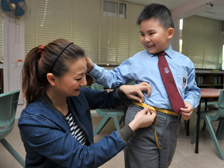
Down sizing:
Seven-year-old Mok Cheuk-cheung’s mother urges him to slim down, as his waistline is 74cm, and he is nearly 4kg overweight for his height and age.
Down sizing:
Seven-year-old Mok Cheuk-cheung’s mother urges him to slim down, as his waistline is 74cm, and he is nearly 4kg overweight for his height and age.

Healthy habit:
The school promotes “Fruit Day” twice a week.
Healthy habit:
The school promotes “Fruit Day” twice a week.

Garden fresh:
To increase their appetite for vegetables, the school cooks vegetables just before serving them to the students.
Garden fresh:
To increase their appetite for vegetables, the school cooks vegetables just before serving them to the students.

Good sport:
Mrs Mok joins Cheuk-cheung in exercise, to encourage him to stay active and slim down.
Good sport:
Mrs Mok joins Cheuk-cheung in exercise, to encourage him to stay active and slim down.
Student learns vital life lessons
March 17, 2013
He may be only seven years old, but Primary 2 student Mok Cheuk-cheung has already learned a vital life lesson: Being overweight is not healthy. With the help of his EatSmart accredited school, he has also mastered the two tools to keeping fit, a healthy diet and regular exercise.
In kindergarten, chubby Cheuk-cheung’s round face drew the attention of a talent scout who selected him as a child model. But weighing 34kg then - the most he has ever weighed - did not make him a model child. He recognises something was wrong.
“I think I am a bit fat. Once I felt my trousers were too tight and I needed to suck in my tummy to squeeze in,” he said.
Like many loving parents, Cheuk-cheung’s mother had overlooked the growing problem.
“I didn't realise my son was overweight until I brought him in for a health assessment, and received professional advice suggesting he was not healthy,” Mrs Mok said.
“When he ran for even a short while, he gasped heavily. At school, he did not get good results in sports, either. What could I do? Then I made up my mind: I should keep my boy fit!”
Cheuk-cheung, who will turn eight in May, is now 126cm tall and weighs 33kg - almost 4kg more than he should for his height and age, but still 1kg less than when he was four. He loves to eat, and his mother admits his overeating began from the age of six months.
Once she understood the problem, Mrs Mok began to alter his diet, giving Cheuk-cheung more vegetables and less meat. She began steaming food rather than deep frying it. And she gave him fruit or soup before dinner and allows him to eat until he feels only 70% to 80% “full”.
Menu planning
His school, Sha Tin Methodist Primary School, has played a key role in helping him become more physically fit. It has attained the EatSmart School Accreditation status, offering healthier lunch and snack options and teaching and promoting healthy eating.
School principal Kan Pui-fan said the concern these days is not that children are undernourished, but that they eat too much meat and not enough vegetables.
“I met a student who never ate vegetables, at school or at home. His teacher encouraged him to eat them, but he refused. The teacher kept reminding him of their benefits, and encouraging him to try, and finally he had his first taste of vegetables,” Ms Kan said.
The school endeavours to encourage students to eat more vegetables. In cooperation with the lunch supplier, fresh vegetables are cooked at the school, just before they are served to students. This measure aims to increase the students' appetite for vegetables.
The school also promotes “Fruit Day” twice a week, and both suppliers and parents prepare fresh fruit for the students.
Waste reduction
During lunchtime, teachers require students to finish all the food on their plates to reduce waste. Leftovers such as seeds and peel are collected for composting, to be used to fertilise the school’s garden.
The school has adopted “Healthy lifestyle” as its annual theme.
“I know leading a healthy lifestyle requires me to eat more fruits and vegetables. I cannot be a couch potato, lying down and watching television while eating. Also, I need to keep fit. Otherwise, I cannot button up my trousers due to my big belly,” Cheuk-cheung said.
Apart from watching what Cheuk-cheung eats, Mrs Mok also ensures he stays active. She brings him to local playgrounds to run, cycle and play basketball, to let him work up a sweat and lose weight.
“This term, he saw an improvement in his sports result, from a B- to a B. He can wear trousers that he could not fit into before,” she said.
Cheuk-cheung is still overweight, though, and he and Mrs Mok hope he can shed nearly 3kg more before his summer vacation.
Early learning
Research confirms that overweight children are likely to grow into obese adults. Evidence is clear that adult obesity is associated with chronic diseases such as heart diseases, diabetes, stroke and cancers.
The good news is, according to the Department of Health’s 2012 study of primary school students’ dietary patterns, the obesity rate among these students is on the decline. It dropped to 20.9% in the 2011-12 school year, from 21.4% in 2010-11, which was down from 22.2% in 2009-10.
The bad news is still one in five primary students is obese.
More than 200 primary schools - about one-third of all primary schools in Hong Kong - have participated in the EatSmart School Accreditation Scheme. Seventy-three of them, including Cheuk-cheung’s, have attained accreditation so far.
Last year, the scheme earned special recognition from the World Health Organisation for its contribution to building a healthy city.